Gold Nanoclusters Grown on MoS2 Nanosheets by Pulsed Laser Deposition: An Enhanced Hydrogen Evolution Reaction
Abstract
:1. Introduction
2. Results and Discussion
3. Materials and Methods
3.1. Preparation of MoS2 Nanosheets on Ti Foil
3.2. Deposition of Au Nanoparticles on MoS2 Nanosheets
3.3. Material Characterization
3.4. Electrochemical Measurements
3.5. Calculation Method
4. Conclusions
Supplementary Materials
Author Contributions
Funding
Institutional Review Board Statement
Informed Consent Statement
Data Availability Statement
Acknowledgments
Conflicts of Interest
Sample Availability
References
- Voiry, D.; Yang, J.; Chhowalla, M. Recent strategies for improving the catalytic activity of 2D TMD nanosheets toward the hydrogen evolution reaction. Adv. Mater. 2016, 28, 6197–6206. [Google Scholar] [CrossRef] [PubMed]
- Han, L.; Dong, C.; Zhang, C.; Gao, Y.; Zhang, J.; Gao, H.; Wang, Y.; Zhang, Z. Dealloying-directed synthesis of efficient mesoporous CoFe-based catalysts towards the oxygen evolution reaction and overall water splitting. Nanoscale 2017, 9, 16467–16475. [Google Scholar] [CrossRef] [PubMed]
- Miao, M.; Pan, J.; He, T.; Yan, Y.; Xia, B.Y.; Wang, X. Molybdenum carbide-based electrocatalysts for hydrogen evolution reaction. Chemistry 2017, 23, 10947–10961. [Google Scholar] [CrossRef] [PubMed]
- Cao, Q.; Zhao, L.; Wang, A.; Yang, L.; Lai, L.; Wang, Z.-L.; Kim, J.; Zhou, W.; Yamauchi, Y.; Lin, J. Tailored synthesis of Zn–N co-doped porous MoC nanosheets towards efficient hydrogen evolution. Nanoscale 2019, 11, 1700–1709. [Google Scholar] [CrossRef]
- He, T.; Nsanzimana, J.M.V.; Qi, R.; Zhang, J.-Y.; Miao, M.; Yan, Y.; Qi, K.; Liu, H.; Xia, B.Y. Synthesis of amorphous boride nanosheets by the chemical reduction of Prussian blue analogs for efficient water electrolysis. J. Mater. Chem. A 2018, 6, 23289–23294. [Google Scholar] [CrossRef]
- Xu, W.; Zhu, S.; Liang, Y.; Cui, Z.; Yang, X.; Inoue, A. A nanoporous metal phosphide catalyst for bifunctional water splitting. J. Mater. Chem. A 2018, 6, 5574–5579. [Google Scholar] [CrossRef]
- Voiry, D.; Mohite, A.; Chhowalla, M. Phase engineering of transition metal dichalcogenides. Chem. Soc. Rev. 2015, 44, 2702–2712. [Google Scholar] [CrossRef]
- Jayabal, S.; Saranya, G.; Wu, J.; Liu, Y.; Geng, D.; Meng, X. Understanding the high-electrocatalytic performance of two-dimensional MoS2 nanosheets and their composite materials. J. Mater. Chem. A 2017, 5, 24540–24563. [Google Scholar] [CrossRef]
- Jaramillo, T.F.; Jørgensen, K.P.; Bonde, J.; Nielsen, J.H.; Horch, S.; Chorkendorff, I. Identification of active sdge sites for electrochemical H2 evolution from MoS2nanocatalysts. Science 2007, 317, 100–102. [Google Scholar] [CrossRef] [Green Version]
- Li, Y.; Wang, H.; Xie, L.; Liang, Y.; Hong, G.; Dai, H. MoS2 nanoparticles grown on graphene: An advanced catalyst for the hydrogen evolution reaction. J. Am. Chem. Soc. 2011, 133, 7296–7299. [Google Scholar] [CrossRef] [PubMed] [Green Version]
- Zhu, J.; Wang, Z.; Yu, H.; Li, N.; Zhang, J.; Meng, J.; Liao, M.; Zhao, J.; Lu, X.; Du, L.; et al. Argon plasma induced phase transition in monolayer MoS2. J. Am. Chem. Soc. 2017, 139, 10216–10219. [Google Scholar] [CrossRef]
- Ren, W.; Zhang, H.; Cheng, C. Ultrafine Pt nanoparticles decorated MoS2 nanosheets with significantly improved hydrogen evolution activity. Electrochim. Acta 2017, 241, 316–322. [Google Scholar] [CrossRef]
- Shi, Y.; Huang, J.-K.; Jin, L.; Hsu, Y.-T.; Yu, S.F.; Li, L.-J.; Yang, H.Y. Selective decoration of Au nanoparticles on monolayer MoS2 single crystals. Sci. Rep. 2013, 3, 1839. [Google Scholar] [CrossRef]
- Ali, A.; Mangrio, F.A.; Chen, X.; Dai, Y.; Chen, K.; Xu, X.; Xia, R.; Zhu, L. Ultrathin MoS2 nanosheets for high-performance photoelectrochemical applications via plasmonic coupling with Au nanocrystals. Nanoscale 2019, 11, 7813–7824. [Google Scholar] [CrossRef]
- Kim, J.; Byun, S.; Smith, A.J.; Yu, J.; Huang, J. Enhanced electrocatalytic properties of transition-metal dichalcogenides sheets by spontaneous gold nanoparticle decoration. J. Phys. Chem. Lett. 2013, 4, 1227–1232. [Google Scholar] [CrossRef] [PubMed]
- Zhang, J.; Wang, T.; Liu, L.; Du, K.; Liu, W.; Zhu, Z.; Li, M. Molybdenum disulfide and Au ultrasmall nanohybrids as highly active electrocatalysts for hydrogen evolution reaction. J. Mater. Chem. A 2017, 5, 4122–4128. [Google Scholar] [CrossRef]
- Zhao, S.; Jin, R.; Song, Y.; Zhang, H.; House, S.D.; Yang, J.C.; Jin, R. Atomically precise gold nanoclusters accelerate hydrogen evolution over MoS2 nanosheets: The dual interfacial effect. Small 2017, 13, 1701519. [Google Scholar] [CrossRef]
- Eason, R. Pulsed Laser Deposition of Thin Films: Applications-Led Growth of Functional Materials; John Wiley & Sons: Hoboken, NJ, USA, 2007. [Google Scholar]
- Kim, S.J.; Kim, D.W.; Lim, J.; Cho, S.Y.; Kim, S.O.; Jung, H.T. Metal contacts on physical vapor deposited monolayer MoS2. ACS Appl. Mater. Interfaces 2016, 8, 13512–13519. [Google Scholar] [CrossRef] [PubMed]
- Gong, C.; Huang, C.; Miller, J.; Cheng, L.; Hao, Y.; Cobden, D.; Kim, J.; Ruoff, R.S.; Wallace, R.M.; Cho, K.; et al. Metal contacts on physical vapor deposited monolayer MoS2. ACS Nano. 2013, 7, 11350–11357. [Google Scholar] [CrossRef]
- Wang, T.; Liu, L.; Zhu, Z.; Papakonstantinou, P.; Hu, J.; Liu, H.; Li, M. Enhanced electrocatalytic activity for hydrogen evolution reaction from self-assembled monodispersed molybdenum sulfide nanoparticles on an Au electrode. Energy Environ. Sci. 2013, 6, 625–633. [Google Scholar] [CrossRef]
- Shakya, J.; Patel, A.S.; Singh, F.; Mohanty, T. Composition dependent Fermi level shifting of Au decorated MoS2 nanosheets. Appl. Phys. Lett. 2016, 108, 013103. [Google Scholar] [CrossRef]
- Jiao, Y.; Zheng, Y.; Jaroniec, M.; Qiao, S.Z. Design of electrocatalysts for oxygen-and hydrogen-involving energy conversion reactions. Chem. Soc. Rev. 2015, 44, 2060–2086. [Google Scholar] [CrossRef] [PubMed]
- Sun, P.; Wang, R.; Wang, Q.; Wang, H.; Wang, X. Uniform MoS2 nanolayer with sulfur vacancy on carbon nanotube networks as binder-free electrodes for asymmetrical supercapacitor. Appl. Surf. Sci. 2019, 475, 793–802. [Google Scholar] [CrossRef]
- Wang, J.; Zhou, Q.; Lu, Z.; Gui, Y.; Zeng, W. Adsorption of H2O molecule on TM (Au, Ag) doped-MoS2 monolayer: A first-principles study. Phys. E 2019, 113, 72–78. [Google Scholar] [CrossRef]
- Yang, Y.-Q.; Zhao, C.-X.; Bai, S.-Y.; Wang, C.-P.; Niu, C.-Y. Activating MoS2 basal planes for hydrogen evolution through the as doping and strain. Phys. Lett. A 2019, 383, 2997–3000. [Google Scholar] [CrossRef]
- Ruffman, C.; Gordon, C.K.; Skúlason, E.; Garden, A.L. Mechanisms and potential-dependent energy barriers for hydrogen evolution on supported MoS2 catalysts. J. Phys. Chem. C 2020, 124, 17015–17026. [Google Scholar] [CrossRef]
- Kresse, G.; Joubert, D. From ultrasoft pseudopotentials to the projector augmented-wave method. Phys. Rev. B 1999, 59, 1758–1775. [Google Scholar] [CrossRef]
- Kresse, G.; Hafner, J. Ab initio molecular dynamics for open-shell transition metals. Phys. Rev. B 1993, 48, 13115–13118. [Google Scholar] [CrossRef]
- Li, K.; Chang, X.; Pei, C.; Li, X.; Chen, S.; Zhang, X.; Assabumrungrat, S.; Zhao, Z.-J.; Zeng, L.; Gong, J. Ordered mesoporous Ni/La2O3 catalysts with interfacial synergism towards CO2 activation in dry reforming of methane. Appl. Catal. B: Environ. 2019, 259, 118092. [Google Scholar] [CrossRef]
- Tsai, C.; Chan, K.; Nørskov, J.K.; Abild-Pedersen, F. Theoretical insights into the hydrogen evolution activity of layered transition metal dichalcogenides. Surf. Sci. 2015, 640, 133–140. [Google Scholar] [CrossRef] [Green Version]
- Liu, L.; Li, X.; Xu, L.-C.; Liu, R.; Yang, Z. Effect of edge structure on the activity for hydrogen evolution reaction in MoS2 nanoribbons. Appl. Surf. Sci. 2017, 396, 138–143. [Google Scholar] [CrossRef]
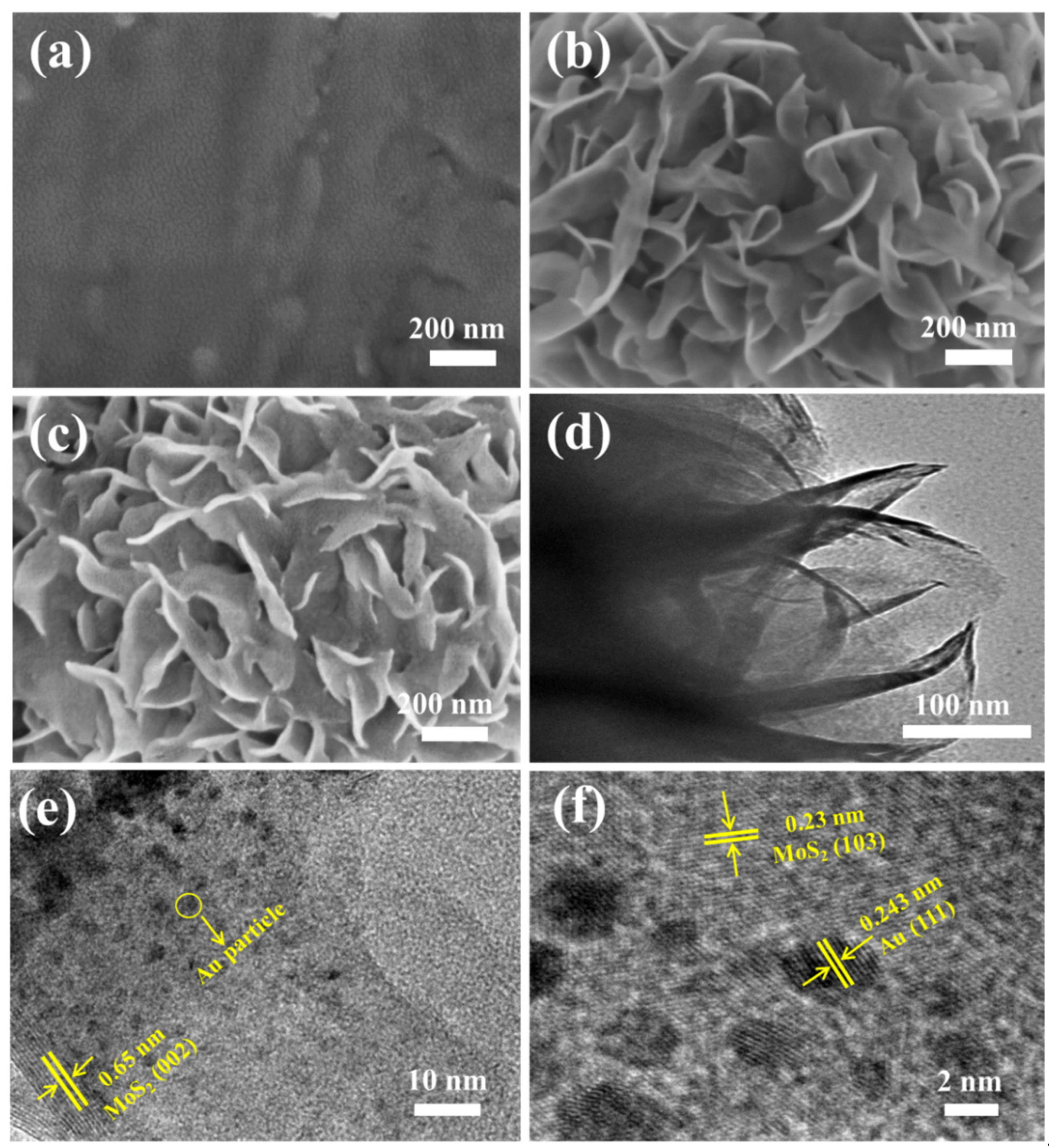
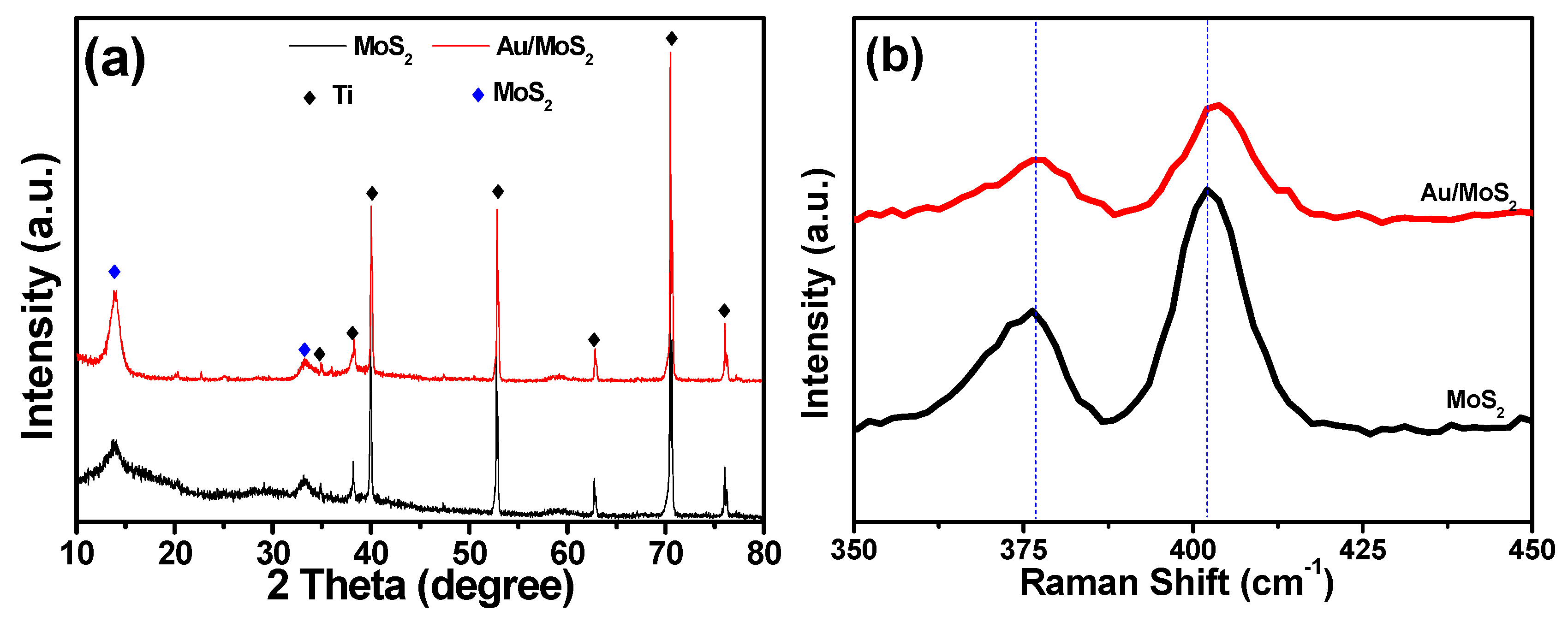

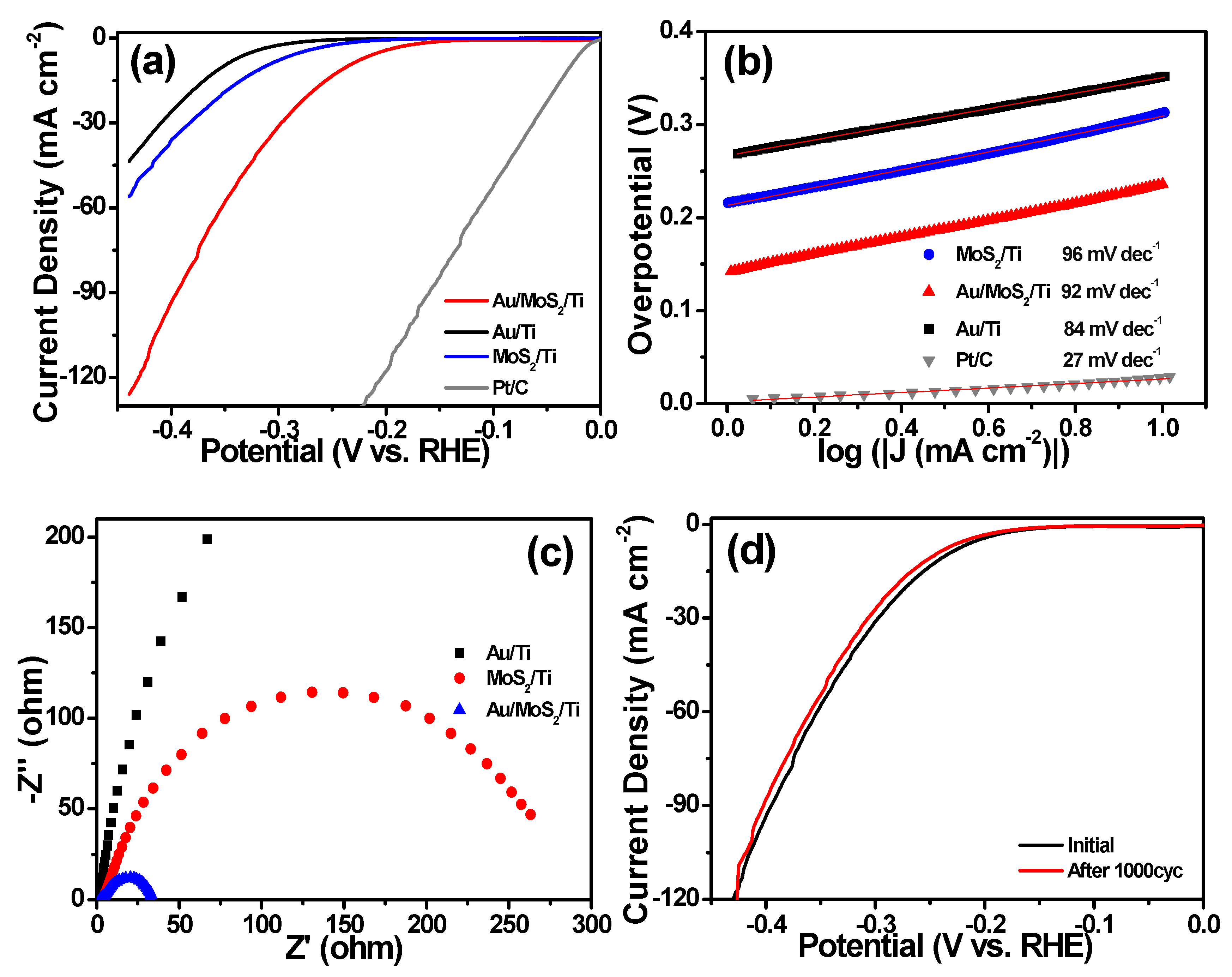
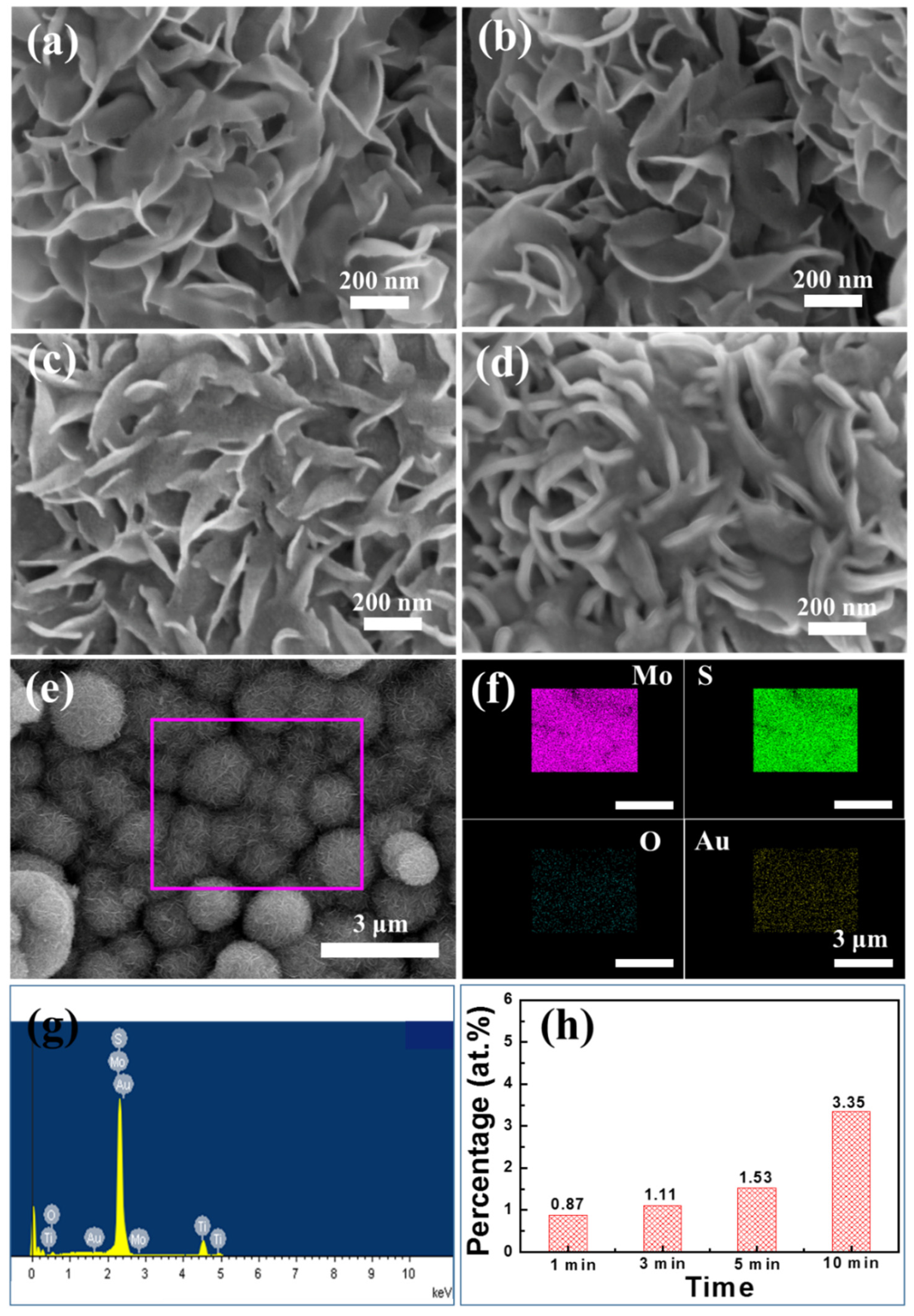

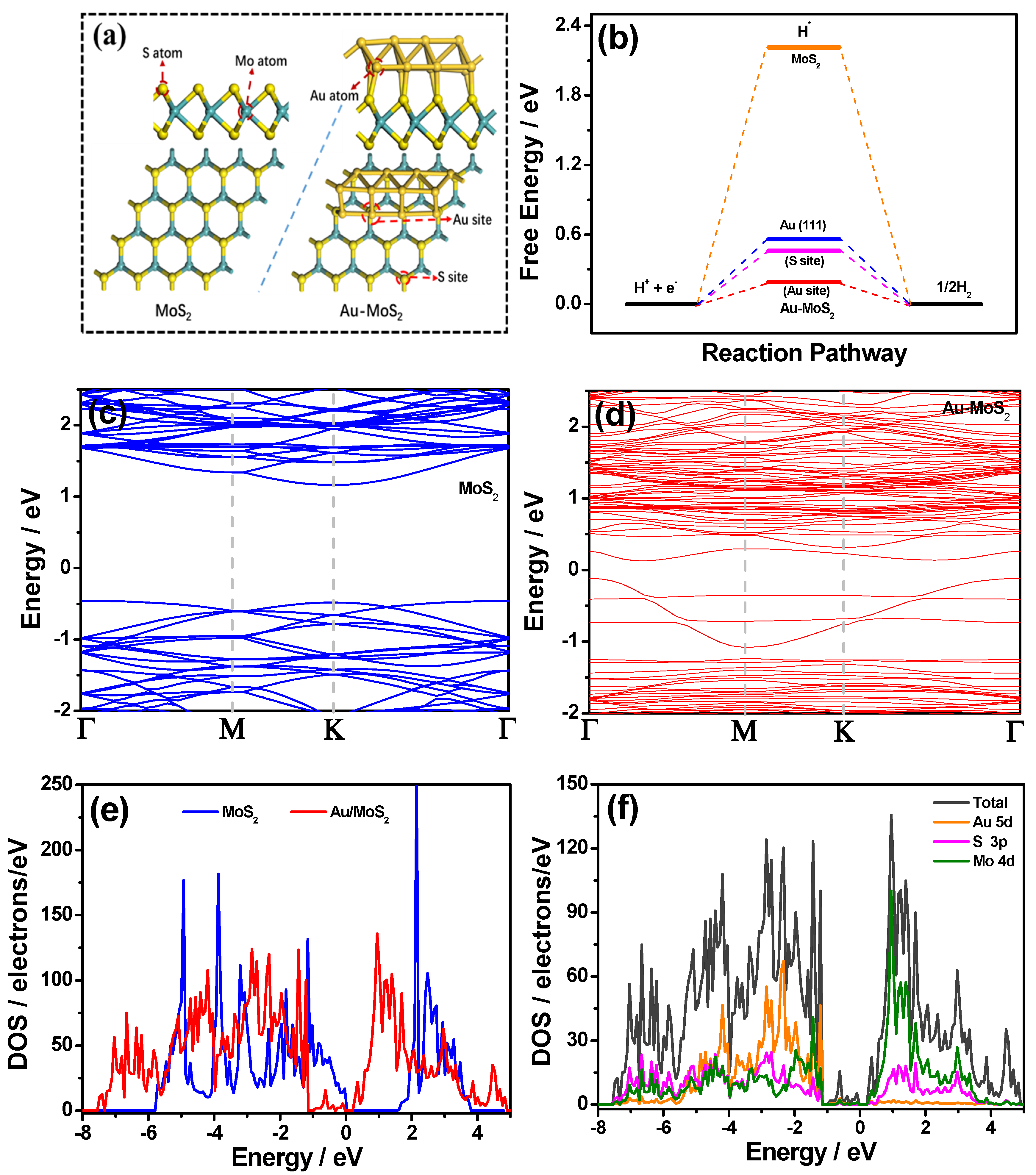
Publisher’s Note: MDPI stays neutral with regard to jurisdictional claims in published maps and institutional affiliations. |
© 2021 by the authors. Licensee MDPI, Basel, Switzerland. This article is an open access article distributed under the terms and conditions of the Creative Commons Attribution (CC BY) license (https://creativecommons.org/licenses/by/4.0/).
Share and Cite
Jing, Y.; Wang, R.; Wang, Q.; Wang, X. Gold Nanoclusters Grown on MoS2 Nanosheets by Pulsed Laser Deposition: An Enhanced Hydrogen Evolution Reaction. Molecules 2021, 26, 7503. https://doi.org/10.3390/molecules26247503
Jing Y, Wang R, Wang Q, Wang X. Gold Nanoclusters Grown on MoS2 Nanosheets by Pulsed Laser Deposition: An Enhanced Hydrogen Evolution Reaction. Molecules. 2021; 26(24):7503. https://doi.org/10.3390/molecules26247503
Chicago/Turabian StyleJing, Yuting, Ruijing Wang, Qiang Wang, and Xuefeng Wang. 2021. "Gold Nanoclusters Grown on MoS2 Nanosheets by Pulsed Laser Deposition: An Enhanced Hydrogen Evolution Reaction" Molecules 26, no. 24: 7503. https://doi.org/10.3390/molecules26247503
APA StyleJing, Y., Wang, R., Wang, Q., & Wang, X. (2021). Gold Nanoclusters Grown on MoS2 Nanosheets by Pulsed Laser Deposition: An Enhanced Hydrogen Evolution Reaction. Molecules, 26(24), 7503. https://doi.org/10.3390/molecules26247503






